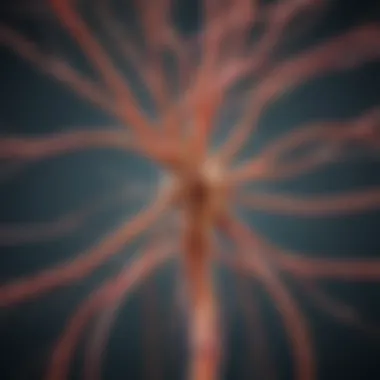Exploring Bulbar Palsy in the Context of ALS


Intro
Bulbar palsy and amyotrophic lateral sclerosis (ALS) share a complex relationship that warrants a closer examination. Bulbar palsy is characterized by the weakness of the muscles controlling speech, swallowing, and other functions of the bulbar region, which includes the brainstem. ALS is a progressive neurodegenerative disease that affects motor neurons, leading to muscle weakness and atrophy. The intersection of these two conditions raises critical questions about diagnosis, management, and the experience of those affected.
In exploring this intersection, a detailed understanding of the symptoms and mechanisms at play is essential. The article aims to illuminate these connections, offering insights for a broad audience including patients, caregivers, and healthcare professionals. The discussion encompasses the implications of bulbar involvement in ALS, explores current research trends, and highlights the importance of supportive care strategies.
Article Overview
Purpose of the Article
The main aim of this article is to carefully unpack the relationship between bulbar palsy and ALS. By doing so, we provide a clearer picture of the challenges faced by individuals with these conditions. An emphasis will be placed on clinical manifestations, diagnostic challenges, and therapeutic strategies.
Relevance to Multiple Disciplines
The relevance of this article extends beyond neurology. Understanding the intersection of these conditions is vital for:
- Healthcare providers who must navigate the complexities of diagnosis and treatment.
- Researchers looking for patterns in symptomatology and mechanisms of disease.
- Educators who train future health professionals.
- Patients and caregivers seeking information to better manage care.
Research Background
Historical Context
The relationship between bulbar palsy and ALS has been observed for decades. Initially, bulbar symptoms were often overlooked in the context of ALS, leading to potential misdiagnoses or delays in appropriate care. Recent studies have started to address this oversight, providing greater clarity on the interrelation between these two conditions.
Key Concepts and Definitions
- Bulbar Palsy: Refers to weakness or paralysis of the muscles innervated by the cranial nerves located in the brainstem. It can occur as a primary condition or as a symptom of ALS.
- Amyotrophic Lateral Sclerosis (ALS): A progressive disease that causes degeneration of motor neurons leading to muscle weakness, respiratory failure, and ultimately death. Bulbar involvement significantly impacts quality of life.
Understanding these definitions is crucial for exploring the future landscape of treatment and care. As we delve deeper, examining the physiological mechanisms, symptoms, and therapeutic options will be our next steps.
Preamble to Bulbar Palsy and ALS
The relationship between bulbar palsy and amyotrophic lateral sclerosis (ALS) is critical in understanding how these conditions affect patients and their quality of life. Bulbar palsy, characterized by dysfunction of the cranial nerves which control speech and swallowing, poses significant challenges for those diagnosed with ALS, a neurodegenerative disease that also impacts motor control. This article delves into the importance of recognizing the intersection between these two medical concerns to facilitate better patient care and management strategies.
Understanding this topic is essential for healthcare professionals, patients, and caretakers. It allows for more targeted interventions and education, which can enhance the quality of life for individuals affected by these conditions. A thorough grasp of symptoms, diagnostic criteria, and treatment options empowers those involved in care to make informed decisions.
Defining Bulbar Palsy
Bulbar palsy refers to a condition marked by weakness or paralysis of the muscles controlled by the brainstem's lower motor neurons. This can lead to notable difficulties in essential functions such as speaking, swallowing, and handling facial expressions. Patients may experience dysphagia and dysarthria, which greatly diminish their ability to communicate and eat. These difficulties often necessitate modifications in diet and communication methods, as traditional approaches may no longer suffice.
The term "bulbar" originates from the word "bulb," as in the bulbous part of the brainstem. This area is critical in relaying signals from the brain to the muscles involved in speech and swallowing. Damage to this region, whether from ALS or other neurodegenerative disorders, can result in significant impairment.
Understanding Amyotrophic Lateral Sclerosis
Amyotrophic lateral sclerosis, commonly known as ALS, is a progressive neurodegenerative disease that affects motor neurons in both the brain and spinal cord. Symptoms typically begin with muscle weakness and may escalate to paralysis. The disease is characterized by the gradual loss of voluntary muscle control, ultimately leading to significant disability and, in many cases, premature death.
The exact cause of ALS remains elusive, with research suggesting a combination of genetic and environmental factors. Those diagnosed might face cognitive changes alongside the physical symptoms. Different types of ALS exist, with bulbar onset ALS specifically impacting swallowing and speech functions from the outset.
The Link Between Bulbar Palsy and ALS
The connection between bulbar palsy and ALS is multifaceted. Bulbar involvement often marks the initial presentation of ALS, highlighting how crucial it is to recognize early signs of bulbar dysfunction in patients. When bulbar palsy manifests in an individual with ALS, it signals a potential decline in overall motor function.
Statistics show that about 25% of ALS patients present with bulbar symptoms as their first indication of the condition. This correlation emphasizes the need for rapid and thorough assessment in individuals presenting with dysarthria or dysphagia.
Understanding this link not only aids healthcare providers in making timely diagnoses but also informs caregivers on what to expect as the disease progresses. Awareness of bulbar involvement can lead to proactive strategies that address both physical and emotional health factors, ensuring a more integrated approach towards patient care.
Physiology of Bulbar Function


The physiology of bulbar function is essential to understanding the connection between bulbar palsy and amyotrophic lateral sclerosis (ALS). This domain encompasses the mechanisms that underlie normal and abnormal functions of the bulbar region, which play a significant role in swallowing, speech, and facial movement. By appreciating the physiological aspects, one can better grasp the impact of ALS on these critical functions and the specific challenges faced by those affected.
Anatomy of the Bulbar Region
The bulbar region is located at the base of the brain, encompassing the medulla oblongata, pons, and midbrain. Each component of the bulbar region has distinct anatomical features that contribute to its overall function.
- Medulla Oblongata: Responsible for vital autonomic functions, such as heart rate and breathing, alongside controlling swallowing and gag reflexes.
- Pons: Acts as a bridge connecting different parts of the brain, facilitating communication between the cerebellum and the cerebrum, which is crucial for regulating facial sensations and motor control.
- Midbrain: Involved in vision, hearing, and motor control, it also plays a part in reflexive responses such as blinking and facial expressions.
This intricate anatomical framework highlights how dysfunction in any of these areas can lead to the clinical manifestations seen in patients with bulbar palsy and ALS.
Neural Pathways Involved
Neural pathways in the bulbar region are critical for coordinating the functions of swallowing, speech production, and facial expressions. These pathways include both afferent and efferent fibers that relay information between the brain and the periphery.
- Corticobulbar Tract: This descending pathway is integral for motor control of the muscles in the face, throat, and tongue. Damage to this tract can result in dysphagia and dysarthria, common symptoms in patients with ALS.
- Cranial Nerves: Several cranial nerves originate in the bulbar region and are involved in specific functions:
- Cranial Nerve V (Trigeminal Nerve): Controls sensation in the face and motor functions such as biting and chewing.
- Cranial Nerve VII (Facial Nerve): Controls the muscles of facial expression; its dysfunction contributes to altered facial expressions in bulbar palsy.
- Cranial Nerve IX (Glossopharyngeal Nerve) and X (Vagus Nerve): Involved in swallowing and controlling the gag reflex.
- Cranial Nerve XII (Hypoglossal Nerve): Controls tongue movements necessary for speech and swallowing.
The interplay of these pathways not only underlines the complexity of functions coordinated by the bulbar region but also emphasizes how disruption in any of these can lead to significant impairments in daily life for ALS patients.
"Understanding the bulbar physiology provides insights into the challenges faced by individuals with ALS, particularly in managing communication and nutrition."
"Understanding the bulbar physiology provides insights into the challenges faced by individuals with ALS, particularly in managing communication and nutrition."
By examining the physiology of bulbar function, one can appreciate the profound effects of ALS on fundamental activities that many take for granted. This understanding lays the groundwork for discussing symptoms, diagnosis, and management strategies in subsequent sections of the article.
Symptoms of Bulbar Palsy in ALS
Understanding the symptoms of bulbar palsy in amyotrophic lateral sclerosis (ALS) is crucial. These symptoms not only affect the quality of life for patients but also present significant challenges for caregivers. Recognition of these symptoms allows for timely intervention and management strategies, which can improve patient care. Additionally, comprehending the symptomatology helps in educating others about the condition, fostering a supportive environment. This section elaborates on specific symptoms, providing a detailed analysis of their implications.
Dysphagia: Swallowing Difficulties
Dysphagia, or swallowing difficulties, is a prominent symptom in patients with bulbar palsy and ALS. This condition stems from impairments in the muscles that control swallowing, significantly affecting nutrition and hydration. Patients may experience difficulty initiating swallowing, leading to coughing or choking during meals. Moreover, the inconsistency in swallowing can result in unintended weight loss and malnutrition, which further complicates the clinical picture.
It is essential to assess dysphagia carefully. Evaluations often include clinical assessments and imaging techniques, such as a Modified Barium Swallow study. These help in determining the safest strategies for eating and drinking. Often, patients may need to adjust their diets to softer foods or liquids that are easier to swallow. Speech therapists play a vital role in providing strategies to manage dysphagia effectively.
Dysarthria: Speech Impairments
Dysarthria is another significant symptom associated with bulbar palsy in ALS. It manifests as slurred or slow speech due to weakness in the muscles involved in articulation. This impairment can lead to frustrations for patients, as communication becomes challenging. There are different types of dysarthria, and the one seen in ALS varies according to the extent of muscle involvement.
Supportive measures often include speech therapy, which focuses on enhancing clarity and improving communication skills. Techniques to help articulate words more clearly and the use of assistive devices for communication can be beneficial. Caregivers and family members must be patient and adaptive to these changes, as this fosters a supportive environment that counters feelings of isolation.
Changes in Facial Expressions
Changes in facial expressions are also a key indicator of bulbar palsy in ALS. With the weakening of facial muscles, patients may struggle to exhibit emotions, leading to a mask-like appearance. This not only impacts their ability to communicate non-verbally but also affects their interpersonal relationships. Friends and family might misinterpret these changes, assuming lack of interest or emotional disconnect.
To address these challenges, awareness and education about the condition are crucial. Caregivers should be encouraged to recognize these changes as part of the disease rather than emotional or behavioral issues. Simple exercises can aid in maintaining some degree of facial muscle tone. Efforts to enhance expression during communication can improve social interaction and overall well-being.
Understanding and addressing the specific symptoms of bulbar palsy in ALS is essential for preserving the quality of life for patients and supporting effective care for caregivers.
Understanding and addressing the specific symptoms of bulbar palsy in ALS is essential for preserving the quality of life for patients and supporting effective care for caregivers.
Diagnosis of Bulbar Palsy in ALS
Diagnosing bulbar palsy in the context of amyotrophic lateral sclerosis (ALS) is crucial as it significantly affects patients' quality of life. Proper diagnosis not only helps in tailoring effective management strategies but also aids in understanding the progression of the disease. Key elements of diagnosis include clinical evaluation techniques, diagnostic imaging approaches, and electrophysiological investigations. Each of these plays a vital role in confirming the presence of bulbar involvement in ALS, helping to differentiate it from other neurological disorders.
Clinical Evaluation Techniques


Clinical evaluation starts with a comprehensive patient history and physical examination. Physicians assess the onset, duration, and progression of symptoms such as difficulty swallowing (dysphagia) and speech impairments (dysarthria). This evaluation can be guided by standardized scales like the ALS Functional Rating Scale-Revised (ALSFRS-R), which helps quantify the impact of bulbar signs on daily activities.
During the clinical exam, clinicians look for specific signs of bulbar dysfunction, such as:
- Weakness of the muscles controlling speech
- Alterations in swallowing reflexes
- Drooling or impaired salivation
The physician may ask the patient to perform various tasks, like counting or reading aloud, to identify speech deficits. These clinical findings help provide clarity on the severity and extent of bulbar involvement in the ALS progression.
Diagnostic Imaging Approaches
Imaging studies are essential in the diagnostic process. Magnetic Resonance Imaging (MRI) is often employed to visualize structural changes in the brain and spinal cord. It is particularly useful in identifying atrophy of regions associated with bulbar function, specifically the brainstem and anterior horn cells.
Additionally, computed tomography (CT) scans can also be used to exclude other possible causes of bulbar symptoms, such as tumors or vascular abnormalities. Targeting these approaches helps to ensure diagnosis is accurate and comprehensive, thereby facilitating timely intervention.
Electrophysiological Investigations
Electrophysiological investigations, particularly electromyography (EMG) and nerve conduction studies, have a prominent role in diagnosing bulbar palsy in ALS. These tests measure electrical activity in muscles and the speed of nerve signals. EMG can demonstrate denervation and reinnervation in the affected muscles, which is indicative of motor neuron dysfunction associated with ALS.
Important Note: It is essential to interpret electrophysiological findings in conjunction with clinical symptoms and imaging results. This holistic approach assists in establishing a definitive diagnosis of bulbar palsy within ALS.
Important Note: It is essential to interpret electrophysiological findings in conjunction with clinical symptoms and imaging results. This holistic approach assists in establishing a definitive diagnosis of bulbar palsy within ALS.
Management Strategies for Bulbar Palsy in ALS
Managing bulbar palsy in the context of amyotrophic lateral sclerosis (ALS) is crucial for improving the quality of life for patients. The symptoms associated with bulbar palsy, including difficulties with speech, swallowing, and facial expression, can significantly impact daily living. Effective management strategies focus on enhancing communication abilities, ensuring adequate nutritional support, and utilizing assistive devices for improved interaction. In this section, we will discuss three major strategies: speech and language therapy, nutritional support, and assistive communication devices.
Speech and Language Therapy
Speech and language therapy plays a central role in addressing the communication challenges posed by bulbar palsy. Tailored interventions from a certified speech-language pathologist can help patients maximize their speech clarity and intelligibility. Therapy often focuses on several key elements:
- Articulation techniques: Patients may learn specific techniques to produce sounds more clearly.
- Resonance training: This focuses on modifying voice qualities to improve overall speech quality.
- Augmentative and alternative communication (AAC): Tools such as communication boards or speech-generating devices may be introduced to facilitate effective communication.
Regular sessions can help patients adapt their communication methods to their evolving needs, allowing them to maintain social connections and express their thoughts more effectively. As bulbar symptoms progress, continuous reassessment of therapy goals ensures for effective communication strategies remain in place.
Nutritional Support and Strategies
Nutritional support is another vital component of managing bulbar palsy in ALS. Dysphagia, or swallowing difficulties, can lead to malnutrition and dehydration. To address this, various strategies are employed:
- Dietary modifications: This may include thickening liquids to prevent aspiration and providing softer food options that are easier to swallow.
- Feeding techniques: Patients can be taught proper positioning and chewing methods to enhance safety when eating.
- Nutritional supplements: These can provide essential nutrients when regular food intake is inadequate.
Collaboration with dietitians is essential to create a customized nutrition plan. This approach ensures that the dietary needs are met while maximizing safety during meals and minimizing discomfort.
Assistive Communication Devices
Assistive communication devices are essential tools that provide an alternative means of expression for ALS patients experiencing bulbar palsy. These devices can support both spoken and written communication in various forms:
- Text-to-speech devices: These allow patients to type out their messages, which are then converted to spoken language.
- Eye-gaze technology: This enables users to control devices using their eye movements, making communication more accessible for those with severe mobility limitations.
- Apps and software: Many smartphone applications offer functionalities for communication, allowing users to use typical devices they already have.
The selection of a suitable device often considers the patient’s specific needs, physical abilities, and preferences. It is important that the patient receives proper training on how to use such devices effectively for day-to-day interactions.
Overall, the implementation of these management strategies seeks to improve the quality of life for those living with bulbar palsy in ALS, addressing critical concerns related to communication and nutrition.
Overall, the implementation of these management strategies seeks to improve the quality of life for those living with bulbar palsy in ALS, addressing critical concerns related to communication and nutrition.
By providing timely and individualized interventions, caregivers and healthcare professionals can help patients navigate the challenges of bulbar involvement, thus maintaining dignity and enhancing social engagement.
Current Research Trends


Innovations in ALS Research
Innovations in ALS research have emerged at a rapid pace, driven by advances in technology and a deeper understanding of the disease pathology. Current research often employs cutting-edge techniques such as gene therapy and CRISPR technology. Gene therapy focuses on addressing the genetic mutations contributing to ALS, potentially altering the disease course.
Moreover, studies are increasingly utilizing patient-derived models, including induced pluripotent stem cells, to study disease mechanisms. These models allow for better insights into neuronal degeneration and the physiological responses involved in bulbar palsy. Recent trials focus on drugs like Riluzole and Edaravone, which show promise in extending survival and delaying symptom onset. As we recognize the genetic and environmental components of ALS, multidisciplinary approaches are becoming essential to developing effective treatment plans.
Emerging Therapies Targeting Bulbar Function
Emerging therapies targeting bulbar function in ALS represent a critical area of patient care. These therapies focus on alleviating the specific symptoms associated with bulbar palsy, such as dysphagia and dysarthria. Recent advancements include non-invasive ventilation and feeding tube placements that can improve quality of life.
In terms of pharmacological approaches, medications affecting neurotransmitter levels are under investigation. One such area of interest is the use of glutamate inhibitors which aim to protect motor neurons from excitotoxicity. Moreover, innovative assistive devices designed to enhance communication for those suffering from dysarthria are also gaining traction. Various applications and devices that convert text to speech are providing much-needed support to patients.
"The ongoing research into ALS not only seeks to develop treatment but also to foster comprehensive supportive care pathways for patient and caregiver engagement."
"The ongoing research into ALS not only seeks to develop treatment but also to foster comprehensive supportive care pathways for patient and caregiver engagement."
As these therapies continue to evolve, incorporating feedback from patients and caregivers will be essential to ensure that they meet the real-world needs of those affected by bulbar palsy and ALS. Continued research thus plays a vital role, enabling healthcare professionals to provide informed, individualized care aimed at enhancing the overall patient experience.
Supportive Care for Patients and Caregivers
Supportive care is a crucial aspect for individuals suffering from bulbar palsy and amyotrophic lateral sclerosis (ALS). The dual challenges presented by these conditions necessitate a multifaceted approach to patient wellbeing. Supportive care focuses not only on managing physical symptoms but also on addressing psychological and social needs. It aims at enhancing the quality of life, providing resources for both patients and their caregivers.
Effective supportive care can lead to better outcomes by facilitating emotional support and improving communication between healthcare providers and patients. It is essential for caregivers as well, who often experience significant stress and emotional fatigue.
Resources for Patient Support
Various resources are available to assist patients facing bulbar palsy and ALS. These include:
- Local ALS Chapters: Organizations like the ALS Association provide a range of services, from support groups to educational materials. They can connect patients with resources tailored to their specific needs.
- Telehealth Services: With advancements in technology, many healthcare providers offer telehealth services. This accessibility allows patients to receive care without the stress of travel.
- Nutritional Consultation: Dieticians can offer practical dietary plans to ensure proper nutrition is maintained, which is vital due to swallowing difficulties associated with bulbar palsy.
- Psychological Support Services: Mental health professionals can provide counseling, helping patients cope with the emotional aspects of their illness.
"Access to resources is not just about information; it’s about empowering patients and their families to make informed decisions."
"Access to resources is not just about information; it’s about empowering patients and their families to make informed decisions."
Utilizing these resources can help create a supportive network, enabling patients to share experiences and strategies for managing daily challenges.
Caregiver Education and Support Groups
Caregivers play a vital role in the everyday management of bulbar palsy and ALS, often carrying the brunt of physical and emotional responsibilities. Educating caregivers is essential as it provides them with the knowledge to effectively support their loved ones. Training can include:
- Understanding the Diseases: Knowledge about bulbar palsy and ALS can help caregivers manage symptoms more effectively and recognize changes in their loved ones’ conditions.
- Coping Mechanisms: Many support groups focus also on teaching coping strategies, which can help caregivers manage stress and avoid burnout.
- Respite Care Strategies: Training can also inform caregivers about respite care options to take breaks when needed, thereby enhancing their own health and wellbeing.
Support groups create a safe space where caregivers can share experiences, strategies, and emotional support.
Closure
The conclusion of this article serves to underscore the profound implications of the intersection between bulbar palsy and amyotrophic lateral sclerosis (ALS). Understanding this relationship is vital not just for medical professionals but also for patients and caregivers grappling with the complexities of these conditions. The nuances of bulbar involvement in ALS can significantly affect the quality of life. Recognizing the symptoms early enhances the chances of timely intervention and effective management, which is crucial for maintaining functionality and reducing discomfort.
Future Directions in Bulbar Palsy and ALS Research
Research in bulbar palsy and ALS continues to evolve, offering hope for better treatment modalities. Investigators are focusing on several areas:
- Genetic Factors: Understanding hereditary patterns may reveal insights into risk factors for developing bulbar symptoms in ALS.
- Neuroprotective Strategies: Research is exploring therapies that could protect neuron function in the bulbar region. These strategies may delay or prevent the onset of symptoms associated with bulbar palsy.
- Clinical Trials: Ongoing studies are testing new interventions aimed at improving swallowing and speech problems, which remain significant challenges for patients.
The integration of multidisciplinary approaches, including rehabilitation strategies and technological advances in communication devices, is crucial. Collaborative efforts across research institutions can lead to innovative solutions that target the specific challenges faced by individuals with bulbar involvement in ALS.
Final Thoughts on Patient Care and Awareness
The role of awareness cannot be overstated in the context of bulbar palsy and ALS. Educating patients and caregivers about the symptoms and available resources is key to effective management. Support networks and educational programs can empower individuals to advocate for their needs.
Furthermore, increasing awareness among healthcare providers about the unique challenges faced by ALS patients with bulbar palsy is imperative. This will facilitate early diagnosis, appropriate referrals, and the development of tailored care strategies.
In summary, the intersection of bulbar palsy and ALS is a significant area of focus that needs ongoing research, enhanced patient education, and effective management strategies. A deeper understanding will equip stakeholders to navigate the complexities of these conditions effectively.



